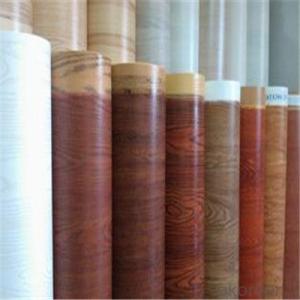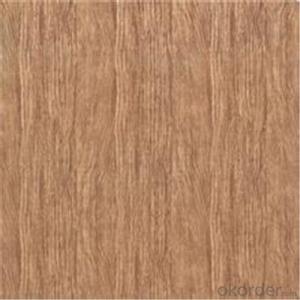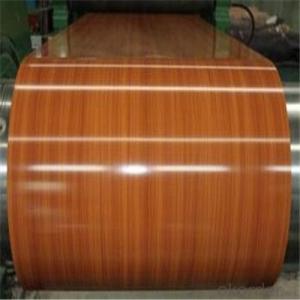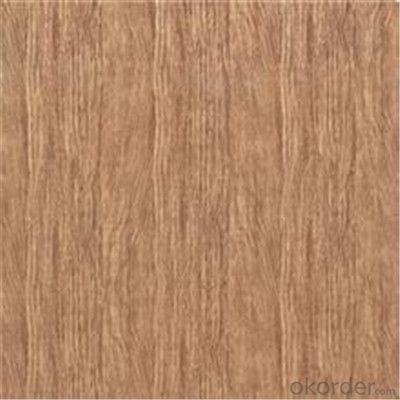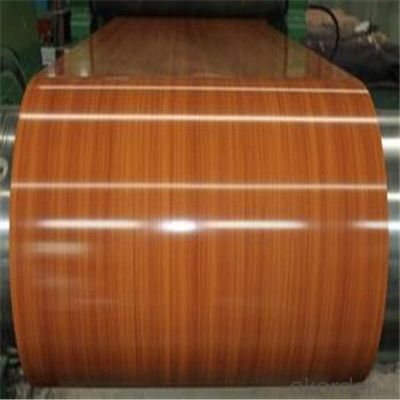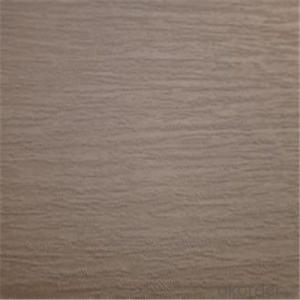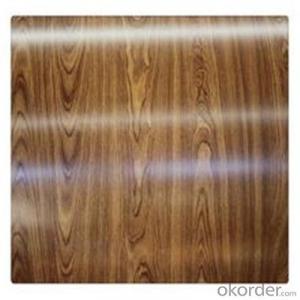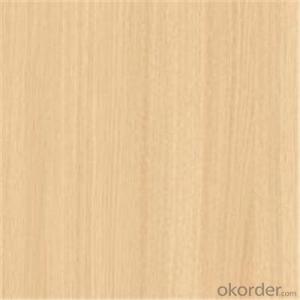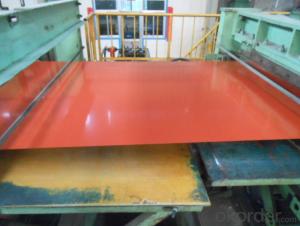Wood Pattern Printed Galvanized PPGL Steel Coil
- Loading Port:
- Shanghai
- Payment Terms:
- TT OR LC
- Min Order Qty:
- 55 m.t.
- Supply Capability:
- 1200000 m.t./month
OKorder Service Pledge
OKorder Financial Service
You Might Also Like
Specification
Description of Glove:
1. Environment friendly
2. Lower cost and maintenance
3. Long using time up to 10 years
4. Fast construction, time saving and labor saving
5. Easy cleaning
6. Antistatic
Festures of Glove:
Building industry | Outdoor application | Roof, structural balcony, panels, window sills, window frames, gates, garage doors, rolling doors, booths, shutters, watch rooms, makeshift houses, street waiting room (booth), refrigerators, etc. |
Indoor application | Room doors, dividing walls, door frames, light house steel structures, sliding doors, screens, ceilings, toilets, interior elevator lobby, stairwayventilating duct, communication pipelines. |
Specifications of Glove:
Standard packing to export:
1) 4 eye bands and 4 circumferential bands in steel
2) Galvanized metal fluted rings on inner and outer edges
3) Galvanized metal & waterproof paper wall protection disk
4) Galvanized metal & waterproof paper around circumference
Images of Glove:
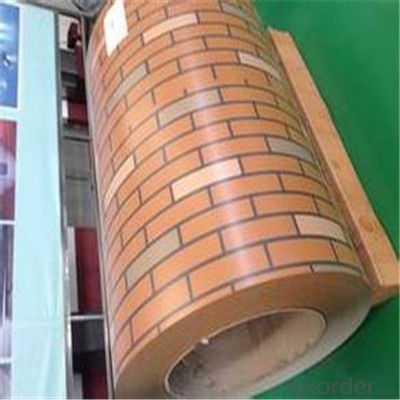
FAQ:
1.What about the delivery.
We can arrange the shipment about 15-25 days after the deposit.
2.What about payment term?
30% T/T deposit, balance against B/L copy.
Full T/T payment if quantity less than MOQ.
3.How much about MOQ?
Normally 100pcs,but small order is acceptable as well.
- Q: How are steel coils used in the manufacturing of industrial compressors?
- Steel coils are used in the manufacturing of industrial compressors as they are shaped and formed into various components of the compressor, such as the casing, cylinder, and piston. The steel coils provide strength, durability, and stability to these components, allowing the compressor to withstand high pressure and perform efficiently in industrial applications.
- Q: benchmade mpr with m390 steel knife. Is it better than d2 s30v or 154cm steel?
- From what I read M390 is relatively wear resistant, with very high stain resistance and good toughness. It is quite hard to qualify steel as better than other steel because it depends on many factors. E.g. for a small folder designed for delicate cutting D2 at high hardness would perform better, but if the environment is corrosive, like saltwater then M390 would be better. I'm not so sure about using stainless steels in large chopping style knives, but I've seen M390 used for them as well. Obviously hardness had to be lowered, which reduces edge holding ability, especially at low angles. Overall, it's a good steel, but if it will outperform S30V or D2 or 154Cm depends on heat treatment and blade geometry, knife designed use, etc.
- Q: what is magnetic steel used for and if it can be used for producing kitchenwares utenils like stainless steel basines,mugs and bowls.
- Magnetic steel rusts. That's why kitchenware is often made out of stainless. You can't turn magnetic steel into stainless, sorry. Metalurgy is a complicated subject, and is all about different alloys. It's far too involved to explain in a few paragraphs here, but no, they're not interchangeable in this case unless you want to produce kitchenware that rusts.
- Q: I am in the US and looking for a price on wide flange steel. I need a price of one W10x30 and 20 feet long.
- The price of steel is increasing daily, so an exact answer is rough. A W10x30 is a fairly common shape and shouldn't be too hard to find. For a very rough ballpark number, say $700/ton (installed price), the piece you require should be in the range of about $250.00 or less as I assume you'll be doing the installing. Please don't take this as the gospel, however. Price varies on location, stock, and availability. Open the phone book and contact your local steel supplier. Because the piece you require is fairly short, you might get lucky and find someone who has a waste piece that length that they will give you a good deal on. --------------------------------------... I just checked the AISC web site to verify the number I quoted above and they posted an article stating that the average mill price had just increased to over $1000/ton in May. The best advice I can provide at this point is to buy the W10 now and don't wait any longer.
- Q: What is the minimum temperature that steel coils can withstand?
- The minimum temperature that steel coils can withstand depends on the specific grade of steel and its intended application. However, in general, most steel coils can withstand temperatures as low as -40°C (-40°F) without significant damage or structural failure.
- Q: How are steel coils used in the production of aerospace structures?
- Various methods are employed in the production of aerospace structures, with steel coils being a key component. Aircraft frames and components are commonly manufactured using steel coils. These coils are processed through a series of operations, such as cutting, bending, and welding, to create the necessary structural members of an aircraft, including fuselage sections, wing spars, and landing gear. The preference for steel coils in aerospace applications is due to their exceptional strength and durability. They are capable of withstanding the immense forces and stresses experienced during flight and landing. By utilizing steel coils, aerospace structures are able to maintain the required structural integrity, even in harsh operating conditions. Moreover, steel coils are also utilized in the production of aerospace fasteners and connectors. These components are crucial for securely holding various parts and structures together. Bolts, screws, and rivets, which are essential for assembling different sections of an aircraft, are commonly manufactured using steel coil materials. The strength and reliability of steel coils make them ideal for fastening applications, ensuring the secure connection of aerospace structures. Additionally, steel coils find application in the production of aerospace equipment and machinery. Heavy machinery and specialized equipment are integral to aerospace manufacturing processes. Steel coils are frequently used in the construction of these machines, as they provide robust and sturdy frameworks. Tooling, jigs, fixtures, and molds, which are necessary for producing aerospace structures with precision and accuracy, often incorporate steel coils. In conclusion, steel coils play a vital role in the production of aerospace structures. They are utilized as raw materials for manufacturing aircraft frames and components, fasteners and connectors, as well as aerospace equipment and machinery. The strength, durability, and reliability of steel coils make them indispensable in the aerospace industry, ensuring the safety and integrity of aerospace structures.
- Q: Steel steps steel guard rail steel chair. You see where I'm going with this.
- The guard rails have to be steel or fans would tear them apart. The steps have to be steel..( although they are not 'solid steel'), in order to hold all that weight of people going up and down them for an entire show. The chairs are very forgiving. All in all, I can see where you are going with this, however it has been this way for decades now. Notice there are no steel tables or steel announcers desks?
- Q: I know that mild steel is more brittle than cast iron....but that is all.......please help??Thank you in advance......Ruby:D
- Actually, the opposite is true. CAST IRON is generally brittle, while mild steel is not. Cast iron has a carbon content from about 2%-4%. Mild steel has less than one tenth as much carbon as cast iron- around 0.2% - 0.3%. Cast iron also typically has from 1%-3% silicon. Most mild steel contains no more than 0.3% silicon. Steel melts at ~1450 degrees C. The addition of large amounts of carbon and silicon to C.I. lower the melting point to around 1200 C and make it more fluid than molten steel. Obviously this makes it easier to melt and to pour. The main advantage of cast iron is it's cheap to produce. It also has some desirable properties despite it's brittleness. For example it's easy to cut and carve with machine tools. It's also very heat resistant and excellent at absorbing vibration. For this reason C.I. was commonly used for engine blocks and exhaust manifolds in cars and trucks in the past, (Cast aluminum engine blocks are more common these days because Al is much lighter and conducts heat better.) Cast iron also rusts much more slowly than steel which is why it's still commonly used for pipes. C.I. pipes have been known to last 300 years.
- Q: hey... i don't need to change my strings, but i found a set of Bronze acoustic guitar strings by pure tone... i have a few questions on them:can i put them on a steel string guitar? i know i can't put nylon strings on... but i don't see why i can't put bronzethey are light gauze... i have no idea what my current gauze is, but i play in Dropped D tuning... so would the E/D string (6th) be too loose? finally, can you get strings designed to be played in Drop D?any help is apprechiated :D
- I don't see why not. Put them on and try it out.
- Q: What is the role of steel coils in the production of conveyors?
- The role of steel coils in the production of conveyors is to provide structural support and strength to the conveyor system. Steel coils are used to create the framework and components of the conveyor, ensuring durability and reliability in moving heavy loads. They are the backbone of the conveyor, allowing it to handle various materials and withstand the stresses of continuous operation.
Send your message to us
Wood Pattern Printed Galvanized PPGL Steel Coil
- Loading Port:
- Shanghai
- Payment Terms:
- TT OR LC
- Min Order Qty:
- 55 m.t.
- Supply Capability:
- 1200000 m.t./month
OKorder Service Pledge
OKorder Financial Service
Similar products
Hot products
Hot Searches
Related keywords
